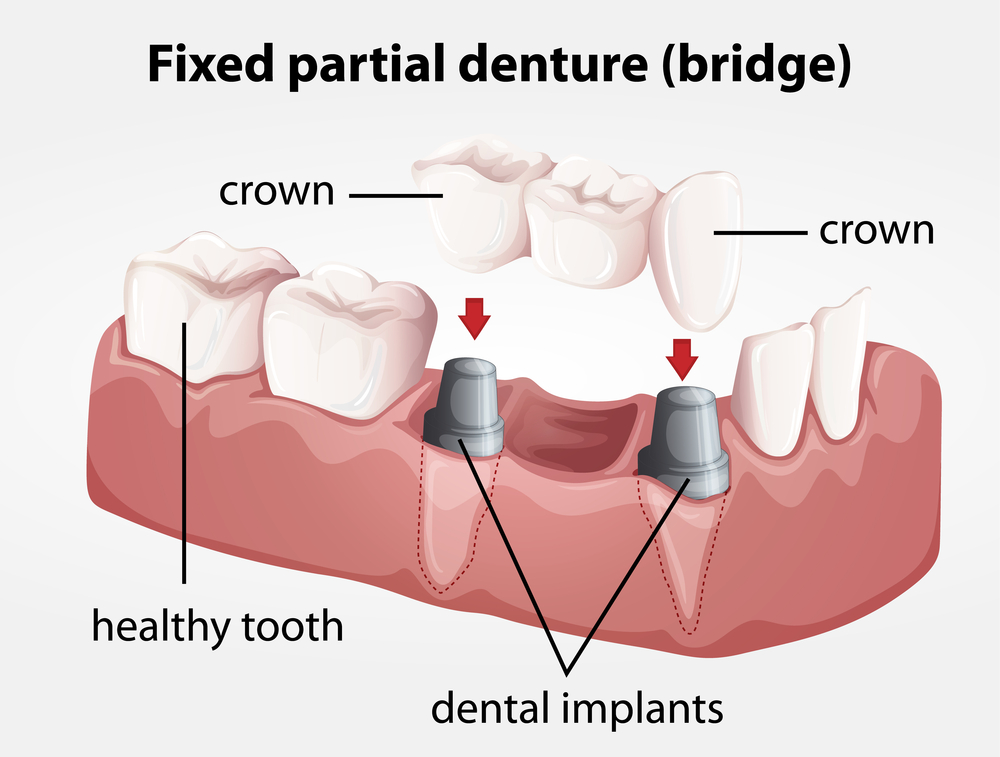1. Traditional fixed bridges
Traditional fixed bridges are undoubtedly the most common type of dental bridges. They are characterized by a filler tooth or fake tooth supported by crowns fixed over healthy teeth situated on either side of a missing tooth. Traditional fixed bridges are usually made using porcelain (ceramic-like material) fused to metal or all ceramic with no metal.
The bridges work well when the missing tooth is in between healthy teeth capable of offering support. The healthy teeth are reshaped before crowns are fitted, and the bridge is installed. Reshaping ensures the teeth can adequately support the bridge.
Traditional fixed bridges stand out for their strength, lightweight nature, and chewing comfort. However, adjacent teeth must be modified/reshaped.
2. Cantilever bridges
While traditional bridges are used when there is a missing tooth and healthy teeth on either side of the gap, cantilever bridges are used when there is a missing tooth and no adjacent teeth on one side. As a result, the bridge is supported by healthy teeth on one side only.
Some clinical situations can warrant the use of cantilever bridges. For instance, they can be used if it isn’t ideal to reshape teeth located on either side of a missing tooth. A typical scenario would be when a front tooth neighbors a missing tooth on one side. Front teeth aren’t ideal candidates for reshaping for aesthetic reasons. Also, traditional fixed bridges won’t work if the missing tooth is a back tooth. What’s more, it isn’t ideal to work with a tooth supporting another restoration.
Cantilever bridges stand out for solving issues that can’t be solved by traditional fixed bridges.
3. Maryland bonded bridges
These types of bridges are popular for replacing missing front teeth. Maryland bonded bridges (or resin-bonded bridges) are characterized by a pontic (artificial tooth) fixed to adjacent healthy teeth using porcelain or metal wings. The wings are attached behind adjacent teeth on either side. The strength of the bridges is dependent on the adhesive used.
Maryland bonded bridges stand out since they don’t require reshaping or placing crowns on adjacent teeth, as is the case with traditional fixed bridges. They are a conservative and cheaper option for those who don’t want traditional bridges.
4. Implant-supported bridges
These bridges resemble traditional bridges in structure. The main difference is how they are anchored i.e., using dental implants instead of crowns. As a result, implant-supported bridges can be used in the absence of adjacent teeth. One implant is usually used for each tooth. However, the bridge can have a pontic suspended between implant-supported crowns, where it isn’t possible to install an implant for every missing tooth.
Implant-supported bridges are a great solution when multiple teeth are missing. They are also extremely strong and durable since they are fitted using implants. Implant-supported bridges are also comfortable with a natural feel.
5. Composite bridges
Individuals looking to replace one or two missing teeth easily and at a bargain can consider composite bridges. They are installed using composite bonding material placed directly into the gap left by a missing tooth. Additional reinforcing wire or ribbond (dental fiber reinforcement) is used in many cases to strengthen the bridge.
Composite bridges stand out for their affordability, simplicity, and speed at which they are installed. The bridges are made and installed in one visit. However, they aren’t as strong as other bridges and could sometimes be considered a temporary solution for individuals who suffer tooth loss due to periodontal diseases and prefer to stay with their teeth to the very end.
Would you like to book an appointment with us? Click on this link or call us at 416-962-4022 for more information!
